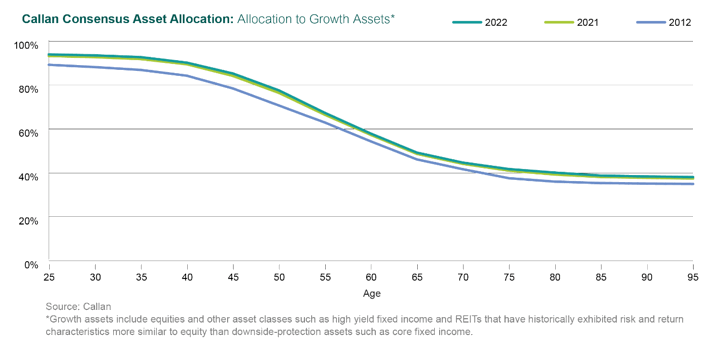Everyday investors now have trillions of dollars invested inside Target Date Funds (TDFs) with their “set-and-forget” simplicity that provides “industry-standard” investment advice for a relatively low cost. Many people are out there selling better solutions, but I think TDFs are a good default that lets you focus on the saving. Another benefit of TDFs is their structure tends to encourage inaction – There was relatively little TDF selling activity during the March 2020 temporary market drop.
The Callan article Target Date Funds and the Ever-Evolving Glidepath reminds us that “industry standard” investment advice is not written in stone. It’s set by big institutions with marketing departments and does change over time. You are handing over the reigns to the fund provider, be it Fidelity, Vanguard, T. Rowe Price, Blackrock, etc.

Here are the overall trends to TDF asset allocation from in the decade from 2012 to 2022:
- Growth assets (stocks, REITs, junk bonds) went up across the board. Ex. At age 25, growth asset allocation grew from 89% in 2012 to 94% in 2022.
- Fixed income (bonds) have gotten slightly riskier credit ratings at younger ages (presumably to boost yield a bit).
- Inflation-sensitive assets (TIPs, commodities) went down across the board in 2021/2022 than in 2012, only to tick up slightly looking forward in 2022.
What I see are big institutions making small, gradual changes to the glidepath, with the directions almost certainly to be towards mild performance chasing. Nobody gets fired from the executive suite for doing that. From 2012-2022, the stock market has done quite well (more of that!), bond yields have been tiny (let’s crank up the risk to boost yield!), and inflation was very mild (less of that, we don’t need to worry about infla-whoops!). If the next decade has low stock returns, high bond interest rates, and lots of inflation, I would expect a reactionary-but-slow turning of the enormous cruise ship.
 The Best Credit Card Bonus Offers – 2025
The Best Credit Card Bonus Offers – 2025 Big List of Free Stocks from Brokerage Apps
Big List of Free Stocks from Brokerage Apps Best Interest Rates on Cash - 2025
Best Interest Rates on Cash - 2025 Free Credit Scores x 3 + Free Credit Monitoring
Free Credit Scores x 3 + Free Credit Monitoring Best No Fee 0% APR Balance Transfer Offers
Best No Fee 0% APR Balance Transfer Offers Little-Known Cellular Data Plans That Can Save Big Money
Little-Known Cellular Data Plans That Can Save Big Money How To Haggle Your Cable or Direct TV Bill
How To Haggle Your Cable or Direct TV Bill Big List of Free Consumer Data Reports (Credit, Rent, Work)
Big List of Free Consumer Data Reports (Credit, Rent, Work)
Speak Your Mind